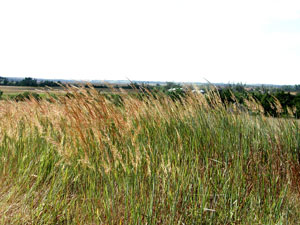Resource Library
Plant of the Week: Indiangrass
The University of Arkansas System Division of Agriculture does not promote, support or recommend plants featured in "Plant of the Week." Please consult your local Extension office for plants suitable for your region.
Plant of the Week
Indiangrass
Latin: Sorghastrum nutans

As a child of the prairie, I’ve always had a fondness for grasses, especially the big, bold ones. The grasses used in landscaping, like almost everything else we encounter these days, are mostly imports from Asia. Indiangrass (Sorghastrum nutans), though, is a homegrown grass with ornamental appeal that should be used more.
Indiangrass is a warm-season clump-forming grass growing up to 6 feet tall with erect stems, but its pendent leaves give it an arching form. From pencil-thin stems (culms), indiangrass produces glabrous green to blue-green foliage that is 3/8 inch wide and 18 inches long. Most of the leaves are produced on the lower half of the culms. In the fall, the leaves turn burnt orange and the plant remains standing into the winter.
Indiangrass bloom spikes appear in late summer at the end of the culm and produce a mass of yellow blooms that are perhaps interesting if you are into the fine detail of nature. The beauty comes when the inflorescence matures into an inverted cone-shaped form bearing the coppery colored seeds. The seed head is not as attractive, nor does it persist as long as those of maidengrass (Miscanthus sinensis), but it is indiangrass’ most distinctive feature.
Though most at home in the prairie states, indiangrass has one of the most far-flung distribution patterns I know of in North America, ranging from the eastern Canadian provinces to Florida and west to Utah and Arizona. It is the state grass of Oklahoma and South Carolina, a state not often associated with prairies.
Prairies – also called steppes, plains, pampas or just grasslands – cover 31 percent of the surface area of the planet and, after forests, are the second most common plant community on earth. Grasses and grasslands appeared in the fossil record at the end of the Cretaceous, soon before dinosaurs went extinct some 65 million years ago. Their appearance and widespread dominance of broad areas of the earth’s surface indicates a general drying of the globe.
Short grass prairies form in areas receiving between 10 and 20 inches of rainfall a year, whereas tall grass prairies, the prairie community to which indiangrass belongs, form in areas receiving 20 to 30 inches of rainfall. These original tall grass prairies must have been a sight to behold. Early settlers and those crossing the Great Plains en route to Oregon or the California gold fields tell of mounted riders disappearing completely in a sea of grass when indiangrass and big bluestem were in flower in the fall.
Forests begin dominating in areas receiving more than 30 inches of rainfall. The Grand Prairie of east Arkansas is an anomaly because it receives plenty of rainfall to support trees, but a shallow hardpan prevents trees from getting established. This same soil layer made it ideally suited for prairie grass, or after 1900, rice production.
As a grass, indiangrass needs at least six hours of full sun per day. It is extremely adaptable to varied soil conditions, thriving on everything from sand to clay, though best performance is in better garden soils. It is a big grass, best-suited for use in naturalized areas in mass plantings or at the back of the border. Once established, it has considerable drought tolerance. It can be divided in the spring, or new plants can be grown from seed.
By: Gerald Klingaman, retired
Retired Extension Horticulturist - Ornamentals
Extension News - November 18, 2011
The University of Arkansas System Division of Agriculture does not maintain lists of retail outlets where these plants can be purchased. Please check your local nursery or other retail outlets to ask about the availability of these plants for your growing area.